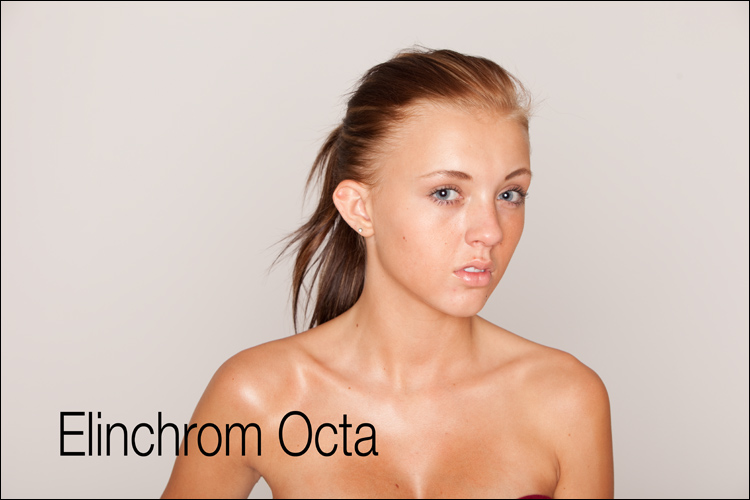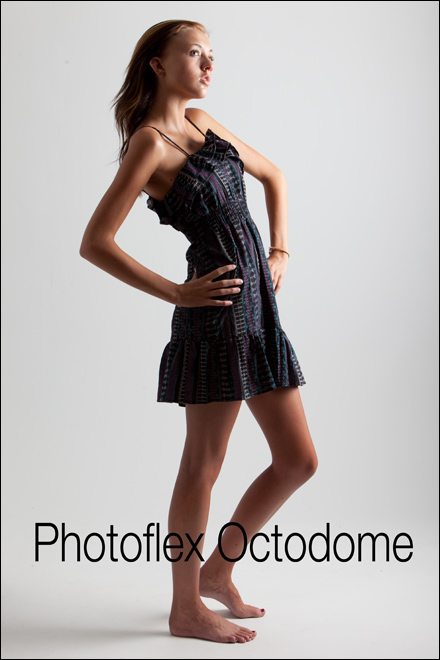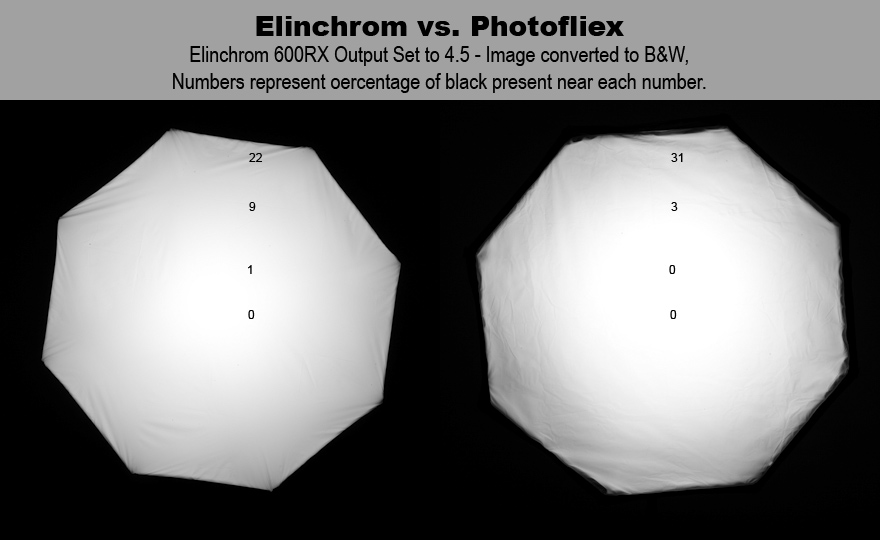First of all, I have no idea why there isn’t a standard name for octagonal softboxes, every company uses their own name – Elinchrom Octa, Photoflex Octodome, Hensel Octaform… it gets confusing! That said the Octagon shaped soft-box is one of my favorite light modifiers. Not only does it make for beautiful catchlights it also wraps around the face and body in a way other soft boxes just can’t seem to pull off.
I wanted to get a new one but I couldn’t really find any good reviews on the differences between brands, so I asked B&H to send me a couple to take for a test drive, thanks so much! A few days later they arrived and the match was set!
Versus
I’m not a professional reviewer so I set out to simply experiment with both softboxes and report on which one I liked best. I selected the Photoflex for the very simple reason that Photoflex soft-boxes have speed-rings that will adapt them to several different brands of strobes and I chose Elinchrom because that is the brand of strobe I currently use in my studio. For this particular test I used the Elinchrom Style 600RX.
In order to keep the results between the two soft-boxes as fair as possible I used the same settings on the strobe without moving the light stand at all between shots, I also kept all the camera settings exactly the same. I had Bailey (the beautiful model) try to hold the same pose between shots. We did this a few times with slightly different styles to get as broad of results as possible.
I didn’t have any expectations going into it, I have used Elinchrom and Photoflex soft boxes and have had great success with both brands. What I found out surprised me.
What’s in the box
Rotalux by Elinchrom Midi Octa
- Octa Softbox with textured silver lining
- Removable Inner/Outer Baffle
- Tent poles
- Speed Ring
- Case with shoulder strap
Photoflex Octadome
- Octadome Softbox with white lining
- Double sided lining, gold or silver
- Octagon lining for back of softbox
- Removable Inner/Outer Baffle
- Speed Ring
- Case with small handle
Thoughts after opening the boxes
Photoflex comes with a lot more stuff, but Elinchrom’s design eliminates the need for a lot of the extras. For instance, the octagon shaped cover for the back of the softbox isn’t needed by Elinchrome simply because the design of the softbox fits perfectly snug with the Elinchrom strobe. This may be because Photoflex is designing their light for maximum compatibility across multiple brands of strobes.
The double sided lining that comes with the Photoflex box is kind of a cool idea. Why you would use a gold reflector? Well if you ever shoot in the shade on a bright sunny day you’ll notice that there is a blue-ish color cast. The reason you get a blue color cast is because the ambient light is blue – mainly because it comes from the blue sky. Since gold is a yellowish color (yellow is opposite Blue on the RGB color wheel) the gold reflector can help correct the blue cast in shadows. If you’re shooting the octa mostly inside a studio (like I am) then the gold reflector is pretty much useless… it is cool to have but it’s also a little bit of a pain to put on.
The texture of the two inner linings is significantly different, the Elinchrom has a raised, pebble like texture that you can see and feel. The Photoflex lining is completely flat (both gold and silver). I’m interested to see if this has any affect on the final images.
Also, the baffles are made out of markedly different material. The Elinchrom material feels more cloth-like whereas the Photoflex baffle feels more plasticky. The cases don’t really affect how they’ll shoot but it’s worth mentioning that the Elinchrom case is much cooler and better quality.
Assembly
I hate putting together softboxes, especially big ones. It’s a hassle.
As far as hassles go the Photoflex was much less stressful putting together, even though I had to put on all the linings the built in tent poles were much easier to manage during set-up. It’s a trade-off though, once finished the Elinchrom had a smoother front to it, all the edges were crisp, it was much, much lighter, and the back of the softbox fit snuggly to the light which eliminated all the nasty spill light. Also, the Elinchrom has zero velcro on it and the Photoflex feels like it was born in a velcro factory.
The Photflex does sell a mesh grid which fits the front of the softbox. An equivalent option is not available from Elinchrom. For this review I both soft boxes without a grid the entire time, I’ll do a separate review on the mesh grid in a later post.
All-in-all, if I were choosing soft-box that I was going to take apart and put back together often I’d probably go with the Photoflex, though if I had the option to leave it constructed most of the time (which I do) then the Elinchrom’s light weight and more solid construction make it a bit more convenient moving around the studio.
Shoot One: Beauty Portrait
On first glance many of you will notice one difference between the two images, the Photoflex seems to be brighter – especially near the center of the image (right around the middle of her face). I think the brightness has to do with the different fabric on each of the softboxes, the Elinchrom’s cloth baffle simply disperses or absorbs the light more than the Photflex.
Brightness aside the Photoflex seems to be a more specular light source than the Elinchrom. Specular vs. diffuse is one of the main principles in the quality of light and generally speaking the smaller the light source the more specular it is, and the more specular a light source is the harder the shadows and highlights are. That’s why an overcast sky (the biggest light source of all) creates nearly zero shadows.
What’s confusing to me is that since the Photoflex soft box is bigger it should be putting out a more diffuse light, but that’s not what is happening.
It’s a very, very subtle difference though, so we’ll take a closer look at what I’m talking about.
Look at the shadows just below her cheekbone on each of these completely un-retouched images. Notice how the edge of the shadow on the Photoflex is just a tad bit more defined than the edge of the Elinchrom? I’m not talking about darkness of shadow, I’m talking about the edge where it transitions from shadow to light. You may need to squint to see it but you’ll notice that the bottom edge of the Elinchrom is very soft, whereas the Photoflex is a little more defined.
This is the exact opposite result of what I would have expected since Photoflex should be the more diffuse light source. I’m not saying that a more diffuse shadow is better in any way. Many jobs call for more defined shadows, in which case a more specular light source is ideal, but a 5′ foot octagon softbox is designed to modify a light into a diffuse source. Certainly this difference is not a major one at all, though it is noticeable to me.
Also, the Elinchrom seems to have slightly yellow color cast to it, again, easily corrected before or after I took the shot – but I wanted these to be with identical settings.
I think both would be an excellent choice for a beauty headshot. I do prefer the Elinchrom mainly because of the subtle hot spot from Photoflex in the center of the image.
Shoot Two: Full Body Side Lighting
Again, the Photoflex appears brighter overall. Both create very useable results. It was only after very careful observation that I realized something really strange. It has to do with the light hitting the model’s left thigh.
On careful inspection (you have to look at how well the light reflects off the top of the thigh) you’ll notice that the light on the Elinchrom image is brighter than the Photoflex image. Which is strange for a couple of reasons, first of all the Photoflex softbox is larger so her leg should be closer to the light source, and the closer the subject is to a fixed intensity light source the brighter that light will appear. Of course spreading the same amount of light across more surface area would definitely decrease the intensity slightly but we already know the Photoflex is producing brighter images overall. Maybe it was just because her leg is bent slightly more towards the light-source in the Elinchrom version – that would definitely cause a brighter light… but I don’t think the difference would be this much. I could absolutely be wrong though, I decided to do another experiment to find out.
Like any 5th grade science teacher will tell you, in order to create a successful experiment you need to develop a hypothesis and then create an experiment to test your hypothesis.
I developed a theory, even though the Photoflex was larger I figured the strobe was not actually spreading it’s light very equally across the front baffle. To test the theory I came up with a plan. I set my aperture to as high as it will go (f32) and shot the front of each softbox directly, at three different power settings. 1.5 | 3.0 | 4.5
The results are below (Elinchrom is on the left, Photoflex is on the right)
After converting these images to black and white I used the eyedropper tool along with the info tab in photoshop to measure the amount of black present at similar points in both lights. I labeled each of these as seen above. This test verifies my theory and explains both issues I was having with the Photoflex soft box, there is a ring of more intense light (with a darker center) in the center of the Photoflex softbox and as the light goes out it stays brighter for longer but then drops off much faster than the Elinchrom.
Shoot 3: Front full Body
Even though the Photoflex appears brighter throughout the entire image you can see that the transition from the tones in her face to the tones in her legs is more drastic than in the Elinchrom version. Not much, but when I look for it I can definitely tell.
Of course I could have shot still images of cubes and cylinders for this light test and we could have eliminated the tiny movements of the model in between tests but overall I think the best kind of test is a real life one. That makes the beautiful Bailey a perfect choice for this experiment and I would like to thank her for her patience while I yelled at her to hold still while I swapped out lights.
The Conclusion?
All in all both, of the soft boxes performed well. If I’m being honest I prefer the Elinchrom. Not only does the light transition more smoothly (with a less-pronounce center hot-spot) but the lighter weight and tighter construction makes it something that is just easier to move around in the studio.
One big complaint about Elinchrom though – I’d really love it if the Elinchrom softboxes weren’t nearly IMPOSSIBLE to remove from the Elinchrom 600RX!
However, it needs to be said that I am certain I could get very useable results from the Photoflex.
Final Retouched Images
Other Equipment used to achieve these images
- Camera: Canon 5D Mark II
- Lens: Canon 70-200 f/2.8L IS USM
- Tripod: Manfrotto 190XPROB
- Tripod Grip: Manfrotto Ballhead (322RC2)
- Memory Card: SanDisk Extreme 16GB
- Strobes: Two Elinchrom 600RX Monolights
- Software: Adobe Lightroom & Adobe Photoshop CS5
























You must be logged in to post a comment.